The first time you see diaper rash it can be a shock, but fixing it up can actually be quite simple. So I asked the folks at Triple Paste if they wanted to partner on a post about the nitty gritty of diaper rash so we can get to the bottom of it (Get used to the bum puns because I’ve got a bunch of them) and you can keep it from rearing (teehee) its ugly head ever again.
Regular Diaper Rash
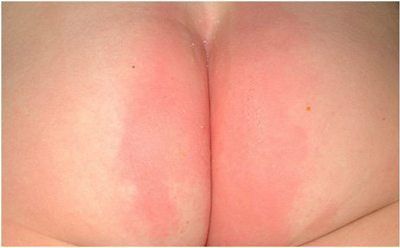
What does it look like?
Diaper rash usually looks red and irritated and is often warm to the touch – it can look similar to a sunburn -with red bumps or chafed or shiny skin in the diaper area. If left untreated, diaper rash can cause open sores and lead to secondary infections caused by bacteria or yeast (fungus).
What can cause diaper rash?
Diaper rash is generally caused by wet stuff being held against the skin. Changes in your baby’s diet can also alter the composition of his/her pee and poop, which may also irritate a sensitive bum. Anything that causes diarrhea, like food sensitivities, food allergies, a change in diet, or antibiotics, can result in diaper rash.
What do you do?
- Dry is the key on this one.
- Change your baby’s diaper more often.
- Use water and a soft washcloth (or wipes that don’t contain any alcohol because that will sting like a mofo on a sore bum) to thoroughly clean the area, then pat dry with a soft towel. (You don’t want to trap in more moisture.)
- Use a barrier cream like Triple Paste to protect the dried area from urine and stools.
- If possible, air that kid’s bum out. If it’s warm out, go outside and take off the diaper and the cream to let the air at the little bum. If you’re inside, put your kiddo sans diaper on a towel – or that ugly blanket Aunt Linda gave you.
- You can also sneak a diaper off during playtime use a towel and a waterproof pad underneath to get some good air.
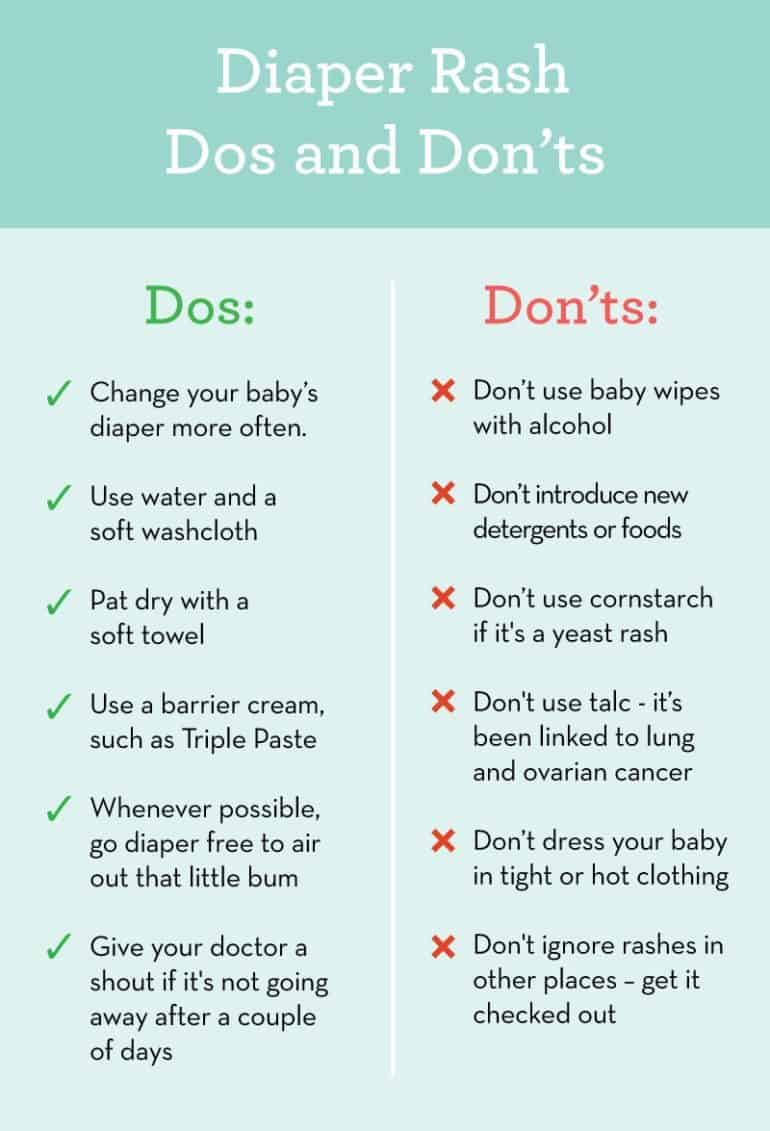
Yeast Diaper Rash
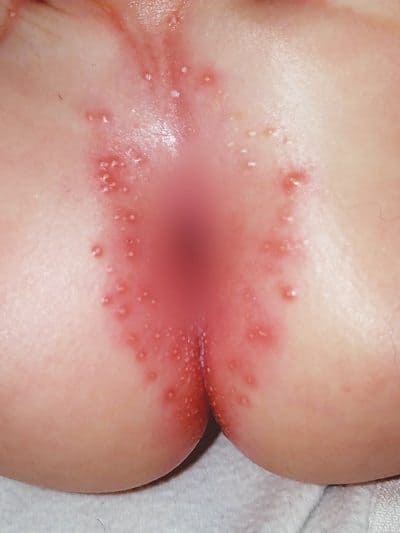
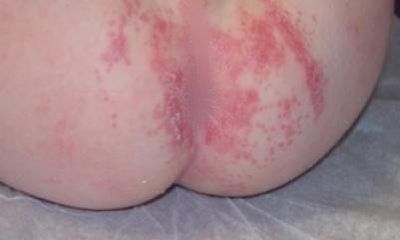
What does it look like?
Well, it looks a lot like diaper rash. However, it often looks really raw with inflamed red bumps and pustules around the edge. It looks beefier than a regular rash and often has raised borders. The biggest clue is that it doesn’t resolve in a couple of days with the treatments you’d use for a regular rash.
What can cause a yeast diaper rash?
Yeast loves to camp out in the dark, damp diaper area. Yeast can crop up after a common course of antibiotics, too, since the drugs kill the good bacteria that typically keep it at bay.
What do you do?
- Apply an antifungal cream to the affected area a few times a day. Creams with miconazole nitrate used to treat jock itch and athletes foot work will work. (Triple Paste has an AF formula that’s a great barrier cream as well.)
- Follow the same treatment regimen as you would for a regular rash – keep the area clean and dry with frequent diaper changes, lots of cream etc. (see above)
- You can use a barrier cream on top of the antifungal cream to keep the moisture away.
- Don’t feed the rash. Yeast loves sugar so cornstarch and even putting breast milk on a yeast rash can fan the flames.
- Consider a probiotic if your baby has been on antibiotics (or if you have been on antibiotics and you’re breastfeeding) to build up some good gut flora.
What can contribute to diaper rash?
If your baby keeps getting diaper rashes, have a look around to see what may be contributing to it. Here are some things you could scrutinize:
- The brand of diaper you’re using
- The brand of wipes you’re using
- Being in hot or humid conditions
- If you cloth diaper, the brand of detergent you’re using. You can also add a half-cup of vinegar to the rinse cycle to naturally soften the cloth and neutralize the ammonia in your baby’s pee.
- Has your baby had a new food? This can change the acidity in urine and stools and irritate skin
- A red ring around your baby’s anus may point to a food sensitivity or allergy
- Teething may also contribute to diaper rash. No one is too sure why but many parents swear it’s true.

When to call in the big guns
- If a rash isn’t going in the right direction after a couple of days, it’s worth having your doctor take a look at it. He or she may want to step up the treatment or switch gears.
- Blisters, sores or anything oozing needs medical eyes on it.
- Not every rash is diaper rash. If your baby has rashes in other places, get it checked out.
Hacks, Tips and Notes for Diaper Rash
(Special shout out to the newsletter readers who offered up suggestions. Thank you!)
- Use a hairdryer or fan set on low/cool to quickly dry the area.
- Silicone Diaper Cream Brushes looks crazy but works well to spread diaper cream easily and evenly
- Many barrier creams are not compatible with cloth diapers. It varies by brand so check the diaper manufacturer to see which ones are a-okay with the cloth diapers you are using. Using a liner lets you put on a thick coating of cream while protecting the diaper shell.
- Coconut oil seems to be a fan favorite for day-to-day prevention, but if your baby’s bum gets red often using a barrier cream like Triple Paste with each diaper change is safe and can help prevent the redness from becoming rash.
- Disposable change pads or puppy pads may come in handy if you’re going diaper free for a bit (don’t use them if your baby is already in a grabby, chewing stage)
- Powders – and even diaper rash sprays – are getting the side eye from medical professionals because babies inhale the particles, which can cause breathing problems and lung damage. However, if you use it sparingly, tapioca, clay arrowroot, and cornstarch seem to be the preferred powders. As mentioned above, cornstarch may exacerbate a yeast rash so skip it if you aren’t sure. Talc has been deemed a no-no for baby’s bum (and lady parts for that matter) – in short, it’s been linked to lung and ovarian cancer. Here are some talc-free suggestions.
- Add 1/4-cup baking soda to your baby’s bathwater to soothe a sore bottom.
- As for diaper creams, it seems to be a very personal preference. Something that was magic on one kid’s butt won’t always work on another’s – that would make life too easy for you. Triple Paste comes up again and again as a reader’s choice and many parents chose it after a lot of trial and error checking out the consistency, thickness, and spreadability of a few diaper creams.
In conclusion
So, to sum it all up, the key to avoiding diaper rash is to keep bums clean and dry and to nip it in the bud before it digs its heels in and becomes a true pain in the ass. (Sorry, but I warned you about the puns.) They are completely common so don’t sweat it if (and when) your baby gets one.
Feel free to pass along any tips you find along the way!
Related: Types of Baby Rashes
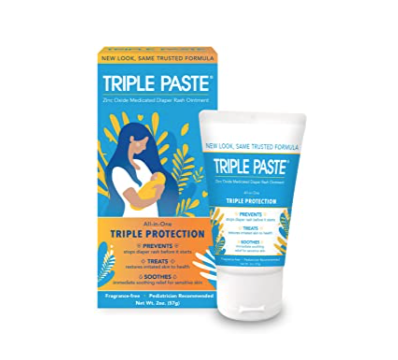
Triple Paste medicated diaper rash ointment is recommended by pediatricians, dermatologists, and generations of parents. It’s a fast-acting, long lasting barrier cream that works quickly to relieve your baby’s raw, irritated skin. It provides serious relief for painful, stubborn diaper rash, yet it is safe enough to use every day to prevent diaper rash from occurring in the first place.
Plus, this hypoallergenic and fragrance-free formula has a thick and creamy consistency, so a little bit goes a long way and lasts a long time. It’s no wonder why Triple Paste has such a loyal following and 5-star reviews.
Triple Paste is available online and at Amazon, CVS Pharmacy, Rite Aid, ShopRite, Target, Walgreens, Walmart, and other fine retailers.




Leave a Comment